Trusted by:
Updated: November 17, 2025
10 min read
How to Increase Online Course Completion Rates?
Low course completion rates can slow growth and drain motivation. See how digital credentials inspire learners to finish—and how Certifier makes issuing certificates effortless.
Across the eLearning industry, course completion rates average just 5–15% for free courses and only 15–40% for paid ones.
Even top learning platforms like Coursera and Udemy face the same challenge: thousands of sign-ups, but few learners crossing the finish line. That gap costs course creators both revenue and credibility.
It doesn’t have to stay that way, though.
The issue isn’t deadlines or content—it’s motivation. When progress feels invisible, learners drift. Digital credentials solve that by making every milestone visible and rewarding.
With Certifier, you can instantly reward progress through digital credentials that motivate learners to finish and share their success—raising completion rates and satisfaction.
TL;DR
Learners drop out mainly due to low motivation and unclear rewards.
Digital credentials act as incentives to help learners finish strong.
Certifier issues branded, verifiable certificates automatically.
Integrations and analytics help track engagement and re-engage drop-offs.
Why learners drop off online courses?
Learners sign up with enthusiasm, but motivation quickly fades. As one Reddit course creator observed, the two biggest factors influencing completion are how much the student cares about the outcome and how well the course supports their progress.

That insight highlights a deeper truth: learners rarely quit because the material is too hard—they quit when the value feels distant or invisible. Here’s what typically goes wrong:
Lack of clear outcomes. When learners can’t connect the course to a concrete benefit, motivation fades fast.
No sense of progress. Long, unstructured courses make it difficult to feel momentum.
Low social connection. Without peer visibility or recognition, learners feel isolated and disengaged.
Overload and fatigue. Cognitive burnout sets in when lessons are too dense or lengthy.
Delayed gratification. Certificates awarded only at the end or those that look generic, fail to sustain motivation mid-course.
Understanding these drivers helps course creators design programs that keep learners emotionally invested and continuously rewarded—something digital credentials can directly support.
Proven strategies to increase course completion
Strong course design doesn’t just win enrollments—it works relentlessly to improve retention through active, student-centered pathways. Below, you’ll find strategic, research-backed approaches that keep learners moving forward instead of dropping out.
01 Break content into short lessons
Long lessons drain attention faster than you think. Learners stay engaged when content is delivered in short, structured modules that feel achievable.

When lessons last only up to ten minutes, it’s easier to stay engaged and avoid burnout. Structuring courses into compact, focused modules creates a sense of steady progress. Learners see results faster and are far more likely to reach the finish line.
02 Make it visual
Visuals aren’t just “nice to have” in online courses–they’re critical. For most learners, content that leans heavily on text or passive video risks losing interest. Here’s how to apply this insight to your course design:
Use diagrams, flow-charts and infographics to break complex ideas into visual chunks. These keep the brain engaged and reduce cognitive strain.
Replace or augment long text slides with interactive charts, annotated screenshots or visuals that instantly communicate meaning. Pairing images with concepts can boost retention significantly.
Work visuals into the full learner journey, not only at the start. For example, use milestone badges, progress bars or visual pathways to show how far a learner has come and how far is left.
Ensure the visual design supports your brand and feels polished—low-quality visuals can undermine the perceived value of your course and thereby your completion rate.
When done right, making your course more visual creates a “seeing = understanding” loop. Learners recognize progress, feel momentum and are far more likely to stay the course.
03 Add micro-assessments & fresh questions
Frequent, low-stakes quizzes give learners a way to check their own progress and stay engaged throughout the course. In one study of 864 first-year online learners, those who completed recurring quizzes logged significantly higher engagement with course materials than those who didn’t.
Instructional designers use this approach to ensure that each attempt feels fresh—and forces learners to think, not just remember. Using a larger question bank with randomized selections means each learner gets a slightly different quiz each time.
04 Encourage community participation
Imagine two online courses:
Course A → Just video lectures, no forums, no peer work.
Course B → Same content, but layered with a welcome thread, buddy system, peer-review assignments and weekly live check-ins.
Which one would you sign up for?
Which one feels like you’re in it alone and which one feels like you’re part of something bigger?
Courses built with community features don’t just look more engaging—they are. Learners in programs with active social elements are reported to be up to 5 times more engaged and nearly 16 times more likely to complete than those on isolated tracks.
Here’s how you bring that into your own course:
Start before learners even begin: a “Welcome” discussion thread, paired introductions and live Q&A.
Use peer-review assignments so students see each other’s work.
Host small “buddy check-ins” weekly so no one falls behind without noticing. When course design builds in connection, the isolation that causes drop-off begins to disappear.
05 From monologue to conversation
Traditional video-lecture formats position learners as passive watchers—and that passivity often leads to disengagement. Interactive, dialogue-style learning drives stronger emotional, cognitive and behavioral engagement online.
Design tip: Replace the monologue model with conversation-driven formats. Use branching scenarios (“What would you do if…”), peer discussion tasks (“Share how you’d apply this”) and prompt comment reflections after key lessons. These elements make learners feel addressed and personally invested.
When the course feels like a dialogue—rather than a solo walk through content—learners become part of the story instead of simply watching it happen. That leading-edge design increases their emotional investment, keeps them motivated longer and drives higher completion rates.
06 Simplify UX and reduce friction
In online education environments, learner engagement drops sharply when access becomes confusing or effort-heavy. UX research shows that even small barriers—like a cluttered login process or unclear navigation—create “digital friction” that causes users to bail out.
Given these insights, simplify your course path:
Enable seamless login mechanisms—such as single sign-on (SSO) or magic links—to reduce access barriers and help you engage learners from the first click.
Create intuitive navigation with clearly labelled menus and minimal clicks between modules, ensuring learners are focused on the course content not wrestling with the interface.
Optimize for mobile devices with responsive layouts and fast load times; in the world of online education, smooth mobile access significantly improves online learning completion data.
Leverage analytics to identify and remove friction points—looks for spikes in drop-off rates (e.g., at login or menu screens), then iterate until the path to content is nearly invisible and learners stay engaged.
When the UX is intuitive, learners stay engaged and are far more likely to complete what they started.
This kind of friction-free design directly supports online course engagement, keeping students focused on learning rather than struggling with navigation or access barriers.
But while these strategies help, the real multiplier comes from giving learners something meaningful to work toward—recognition that matters.
How do digital credentials improve course completion rates?
Research into online learning reveals a clear pattern: when courses offer no meaningful reward, completion rates often linger in the 10–20% range.
In contrast, programs that build in credential-based rewards can push rates up to 30–45% or more. This gap strongly suggests that when and how a certificate is issued matters–a delayed or under-whelm reward equals weaker finish rates.
In the following section, we’ll explore how integrating the right digital credentials at the right points in the journey can shift your completion data.
Recognize effort with verifiable certificates
When learners reach the end of their learning journey, a branded certificate can serve as a powerful signal of achievement—not just for the individual, but for everyone who sees it.
That’s why Certifier, software for certification management, enables you to deliver a professionally designed, verifiable online course completion certificate that can amplify both recognition and value.
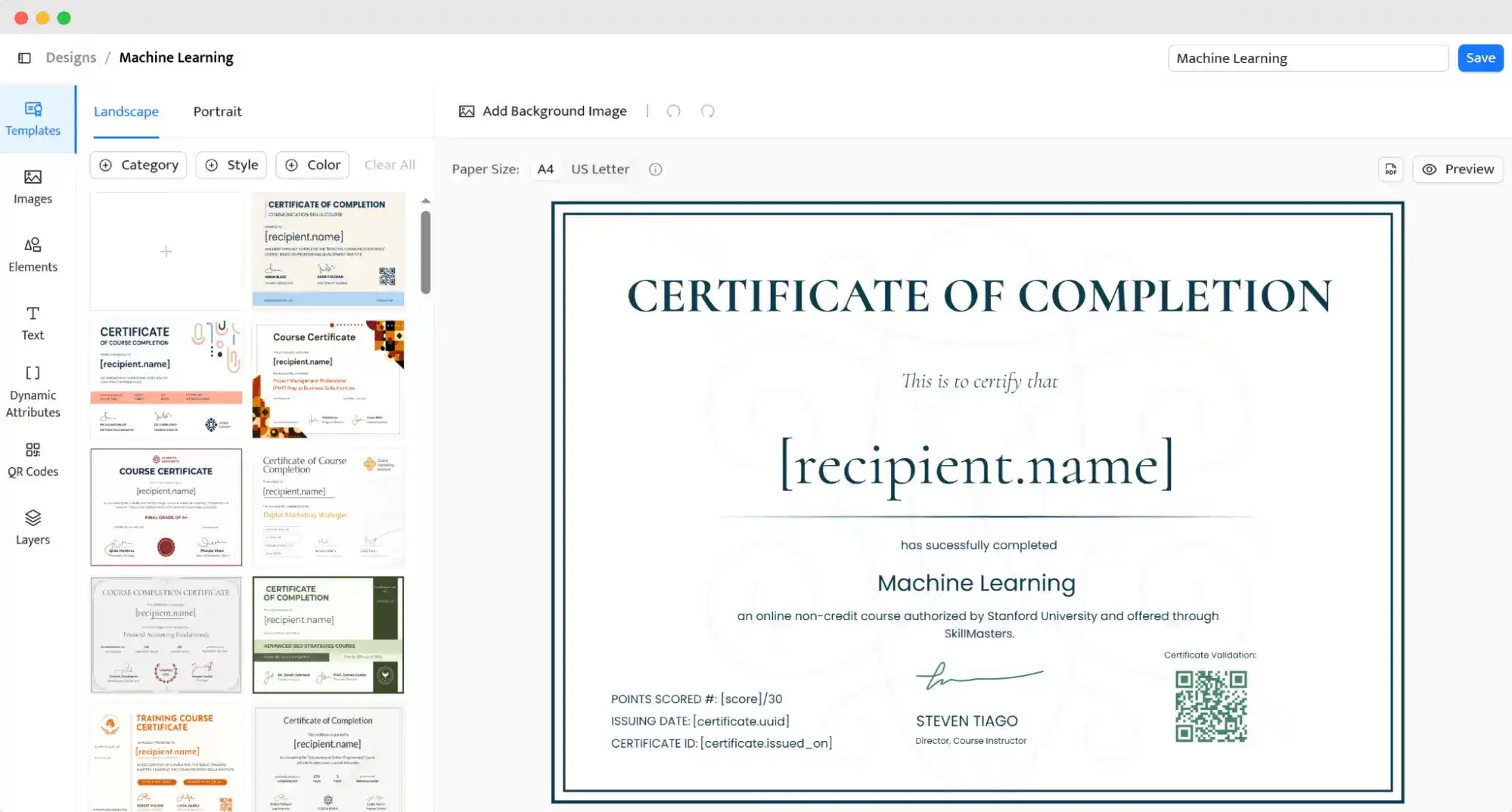
Many learners are interested in acquiring more than just knowledge—they’re building soft skills like communication, leadership or problem-solving.
A certificate that reflects those skills becomes part of their professional identity and encourages them to complete the course rather than dropping off.
What’s more, the way learners behave—especially their engagement patterns—changes when they know a clear reward is waiting.
A certificate issued instantly after completion becomes a snapshot of success, helping to keep the motivation high through to the finish line.
Create and Send Digital Credentials

With Certifier, you can:
Instantly reward progress through digital credentials that motivate learners to finish and share their success—try to issue a certificate for completing a course and turn achievement into momentum
Provide recipients a share-ready link for platforms like LinkedIn or email signatures, turning their achievement into a visible, public milestone
Track sharing and clicks to understand how your credential is performing and refine future course offerings based on real-time data
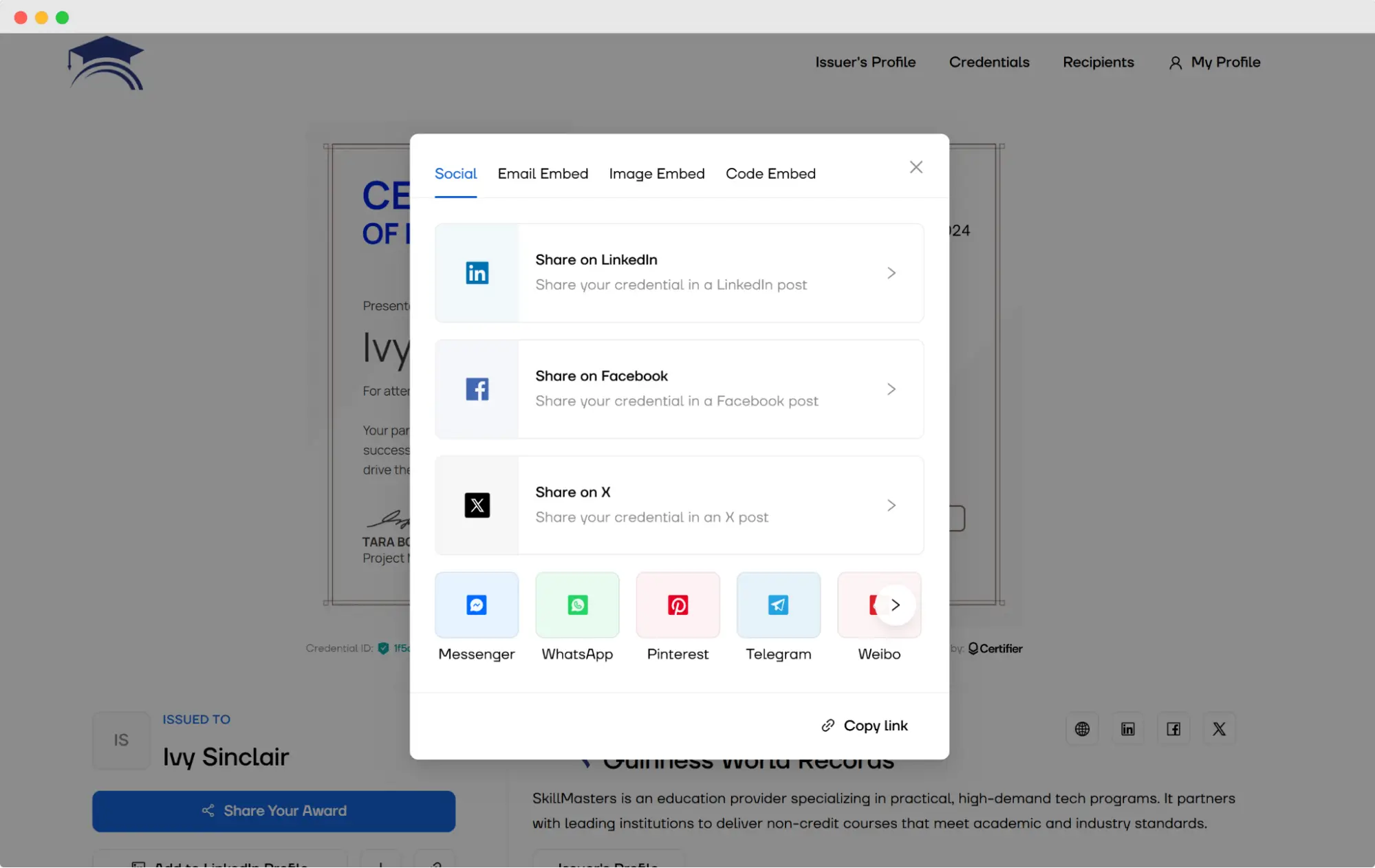
Designing certificates as a visible marker of progress changes the dynamic of your course. It signals that you’re invested in their success and helps keep them engaged from day one to the last module.
Use microcredentials to motivate progress
When a program lets learners cross multiple visible milestones, their motivation stays active—not just at the end but throughout the learning journey.
Long courses lose learners when the goal feels distant—microcredentials reverse that by creating shorter milestones and issuing certificates at each stage to sustain engagement.
With this structure:
Learners feel an immediate reward rather than waiting for the final certificate.
Each completion triggers a small badge or credential, aligning with the engagement patterns seen in modern online learning programmes.
The visible milestones become proof of skill—especially valuable when learners aim to build targeted competencies.
Gamify learning with badges and recognition
Ever asked yourself “What could be improved in this course?” only to realise your learners never knew where they stood?
Introducing badges and recognition into your course can shift from “complete because you have to” to “complete because you want to.” Research shows that gamification in online learning environments—badges, points, leaderboards—positively influences engagement patterns and motivation.
Badges like “Top Forum Contributor” or “Quiz Master” tap into friendly competition and a sense of achievement. They help learners feel seen, acknowledged and motivated to push forward.
With Certifier, you can adjust digital badge templates and integrate them into your system—so each badge aligns with your brand and supports your course goals.
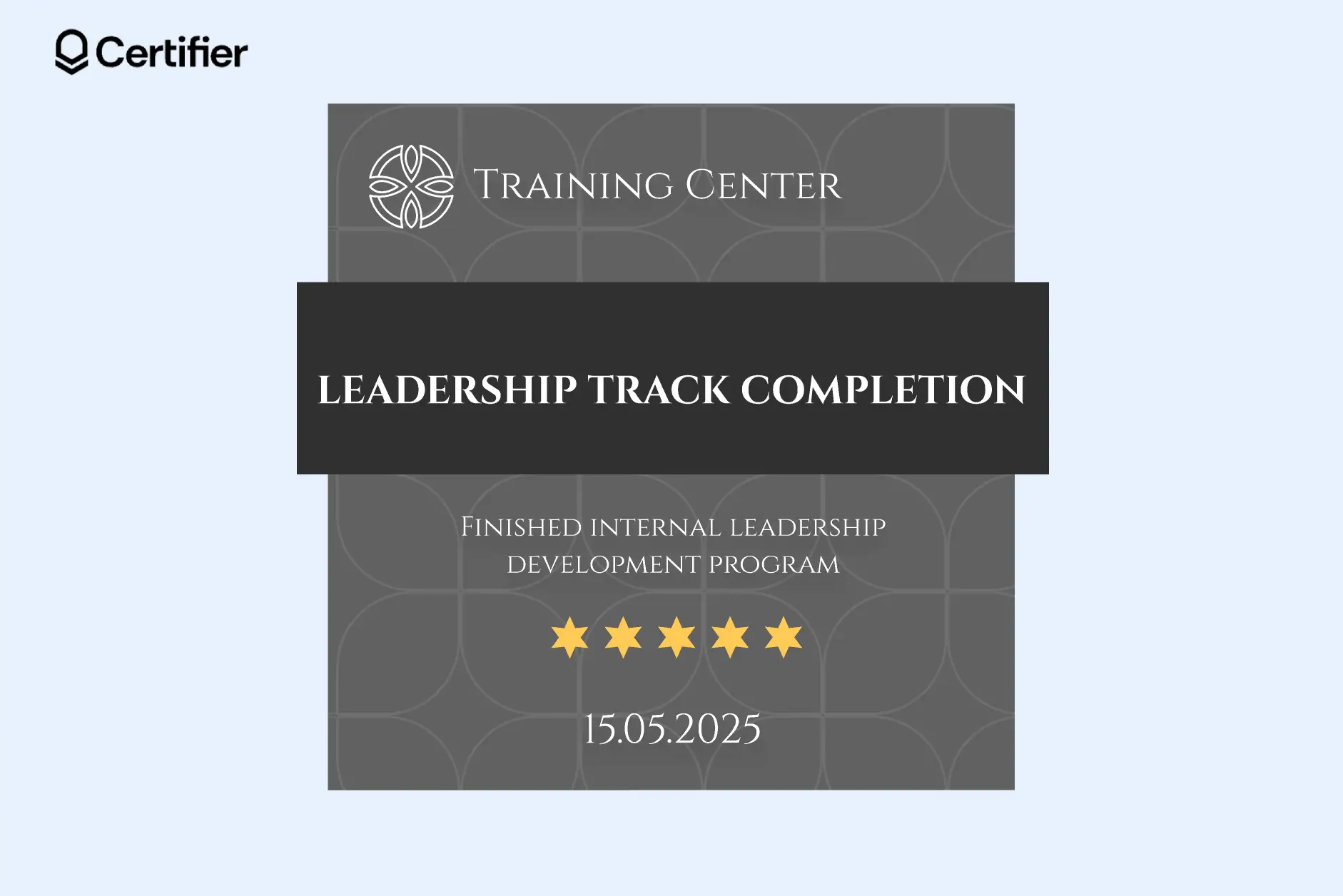
It’s a digital badge template free to edit. See the digital badge gallery to choose a customizable design.
Automate issuance through LMS integrations
Waiting for learner certificates to be manually processed takes the wind out of the process. In the online learning, delays—even small ones—break the rhythm and quiet motivation.
Here’s a quick, low-stress setup using Certifier:
Connect your platform (Teachable or spreadsheet) for example, via Google Sheets, Excel or Zapier) so you don’t manually trigger each certificate
Set the trigger: when a learner completes the final module, the certificate is automatically issued
Make sure the certificate lands instantly and learners can share it if they choose
This path keeps learner focus on your course content and not on hidden admin steps. When the reward timing aligns with completion, engagement patterns stay strong throughout the duration of your course.
Track engagement with Pathway Analytics
In massive open online and distance learning environments, it’s not enough to simply launch a course and hope learners complete it.
Without insight into drop-off points or engagement trends, you’re operating blind. And that lack of visibility into learner behavior often leads to stagnating completion rates.
With Certifier’s Pathways analytics dashboard, you get precise tools to monitor your learners’ journey in real time.
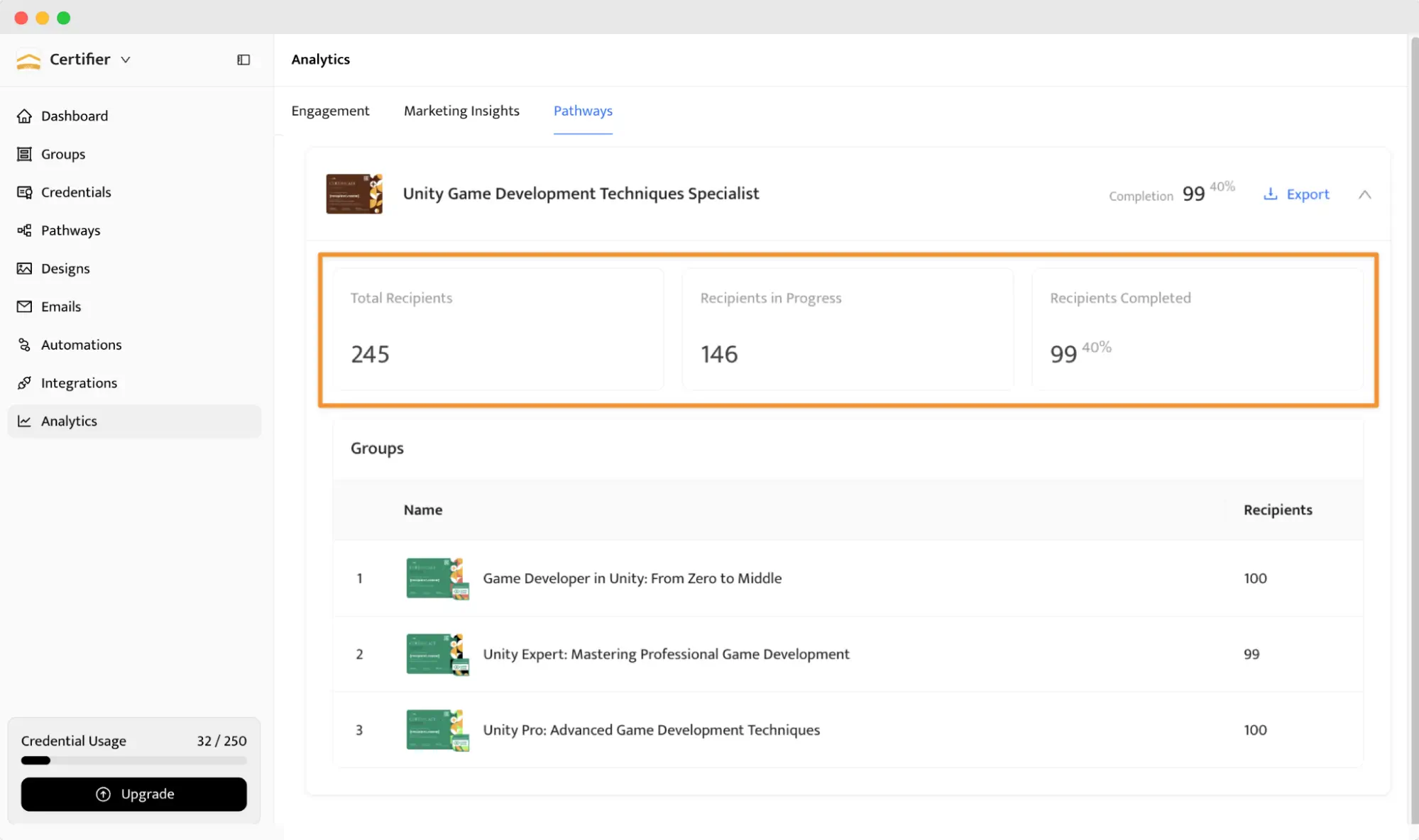
You can view the number of learners enrolled, those still in progress and exactly where they stopped—module by module.
Here’s how to make it actionable:
Use analytics to identify modules with high drop-off and decide whether they need redesign, tighter pacing or added incentives.
Leverage data on collaborative learning and peer interactions (forum posts, group tasks) to spot if learners aren’t engaging socially, which often precedes leaving a course.
Launch re-engagement campaigns automatically for learners who halt at specific steps—whether that’s an unfinished assessment or an inactive discussion thread (learn how to re-engage course takers).
Adjust your course mechanics based on live insights, not assumptions, so your learning journey stays aligned with actual learner behavior.
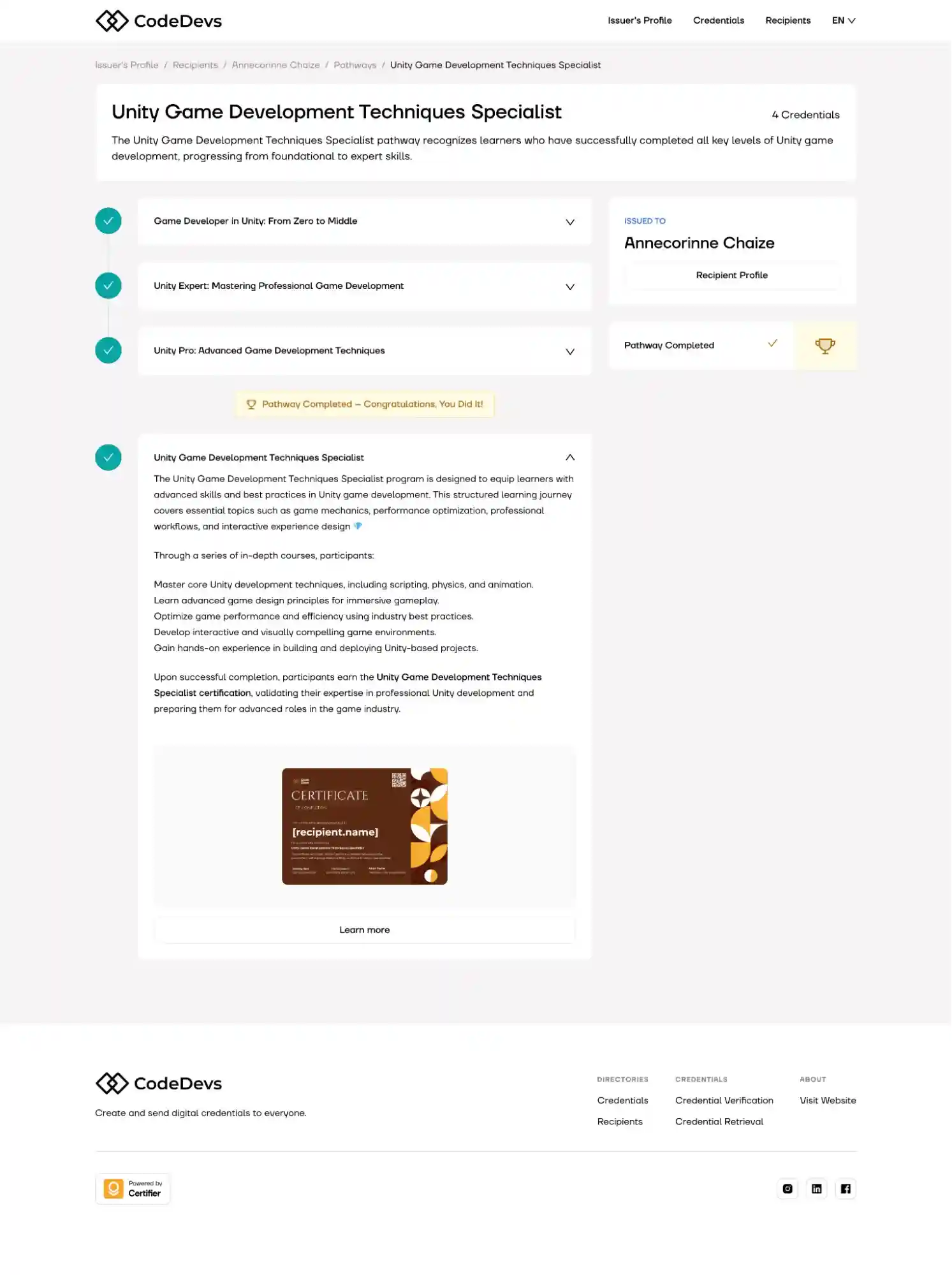
Make certificates worth sharing
When learners complete a course, the moment of achievement often gets buried behind admin and clutter. That missing “celebration” can quietly undermine improving completion rates and stop learners from feeling fully rewarded.
When recognition is visible and valued, retention improves and outcomes strengthen.
With Certifier, you can turn credentials into a shareable reward rather than another PDF locked in inboxes:
First, choose one of our course certificate templates and brand it with your colours, logo and narrative.
Next, set it up so every learner who completes your program receives the certificate automatically, with a link ready for sharing on platforms like LinkedIn. With one-click sharing to LinkedIn, Certifier turns every achievement into a promotional asset for both learner and instructor. Each shared credential reinforces your brand’s credibility and expands your reach organically.
Finally, highlight that share: when your learners post their achievement, you not only showcase their growth, but also build momentum for the next cohort—leveraging collaborative learning and peer influence as part of your retention strategy.
Plus, every learner receives a credential retrieval and verification page—so even if they lose the original email, they can still access, verify and showcase their certificate anytime. This consistent accessibility strengthens the perceived value of completing your course.
Certifier doesn’t stop at issuing credentials—it keeps them discoverable. And when the credential looks sharp, feels official and is built to be shared—it tells learners loud and clear that finishing the course mattered.
Increase online course completion rates using digital credentials
Structural change, not just surface fixes, drives real improvement in online course completion rates. While countless creators focus on content upgrades, the real lever lies in digital credentials—when designed and deployed correctly, they act as persistent motivators rather than afterthoughts.
As the latest online course completion rates statistics show, engagement, recognition and timely reward are what separate thriving courses from those that stall.
Re-imagine your course design: build around milestones, embed recognitions at key moments and make finishing not only possible, but expected. Start treating completion as the outcome, not the exception.
Create your first credential-free course certificate today and start turning learners into completers. Sign up for Certifier to start.
FAQ: Increasing online course completion rates
Have questions about how to measure, analyze and improve your online course completion rates? Here are clear answers to the most common queries from course creators and educators.

- SaaS Growth
- Digital Credentials
- APIs
- Product Marketing
- Company Operations
CEO and Co-Founder
Sergey is CEO and Co-Founder of Certifier, a Forbes 30 Under 30 honoree building digital credential infrastructure for 2,000+ organizations worldwide and shaping the future of credentialing.


